|
Membrane potential |
|
Refers to a separation of charges across the membrane or to a difference in the relative number of cations and anions in the ICF and ECF. |
| |
|
What maintains the membrane potential? |
|
The membrane potential is maintained by the Na+/K+ pump. |
| |
|
NA+/ K+ pump |
|
The Na+/K+ pump is found in the membranes of many types of cells. In particular, it plays a very important role in nerve cell membranes. |
| |
|
What leads to a nerve impulse? |
|
Notice that 3 positive ions (Na+) are pumped out of the cell (towards ECF) for every 2 positive ions (K+) pumped into the cell (towards ICF). This means that there is more positive charges leaving the cell than entering it. As a result, positive charge builds up outside the cell compared to inside the cell. The difference in charge between the outside and inside of the cell allows nerve cells to generate electrical impulses which lead to nerve impulses. |
| |
|
Permeability properties of the membrane at rest |
|
About 50 to 75 times more permeable to K+ than to Na+. |
| |
|
Voltage |
|
It is the difference of electrical potential between two points |
| |
|
Current |
|
The flow of electrical charges |
| |
|
The resting membrane potential |
|
the membrane potential that exists when an excitable cell is not displaying an electrical signal. (Positive outside/negative inside- difference across the concentration gradient)
|
| |
|
What kind of tissue are neurons and muscles? |
|
Neurons and muscles are excitable tissue |
| |
|
Cell body |
|
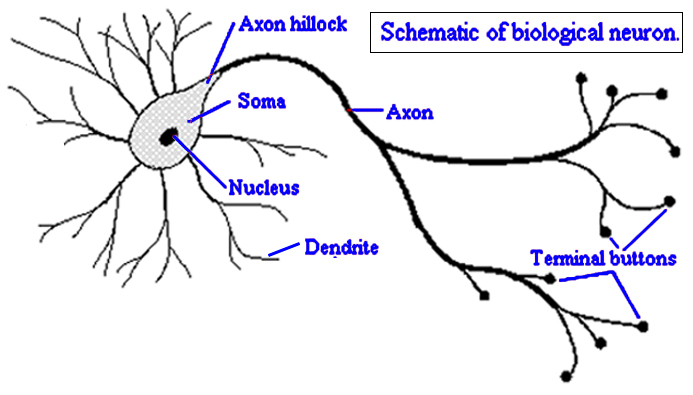
Also known as the soma, houses the nucleus and organelles. |
| |
|
Dendrites |
|
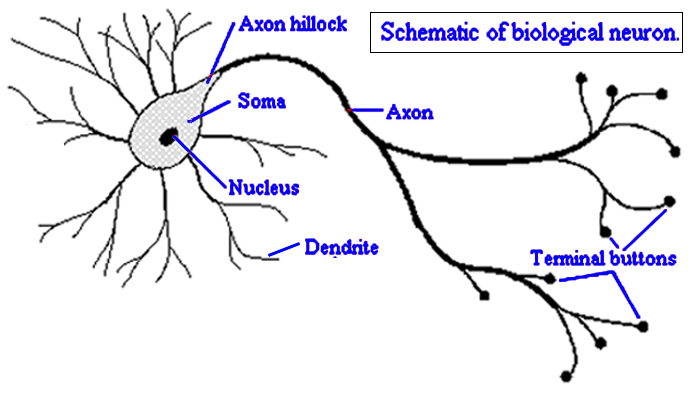
Extensions coming from the cell body, typically project like antennae to increase the surface area available for receiving signals from other nerve cells. Carry signals toward the cell body, and contain protein receptors for binding chemical messengers from other neurons.
|
| |
|
Axon |
|
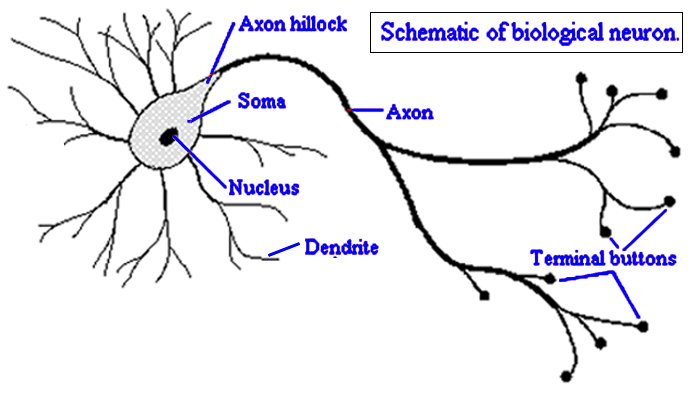
A nerve fiber, a single, elongated, tubular extension that conducts action potentials away from the cell body and eventually terminates at other cells.
|
| |
|
Graded Potentials |
|
Local changes in membrane potential that occurs in varying grades or degrees of magnitude or strength. |
| |
|
What happens during a graded potential? |
|
Graded potentials are usually produced by a specific triggering event that causes gated ion channels to open in a specialized region of the excitable cell membrane. (The stronger the triggering event, the more gated channels that open, the greater the positive charge entering the cell, and the larger the depolarizing graded potential at the point of origin. Also, the longer the duration of the triggering event, the longer the duration of the graded potential)
|
| |
|
Action potential |
|
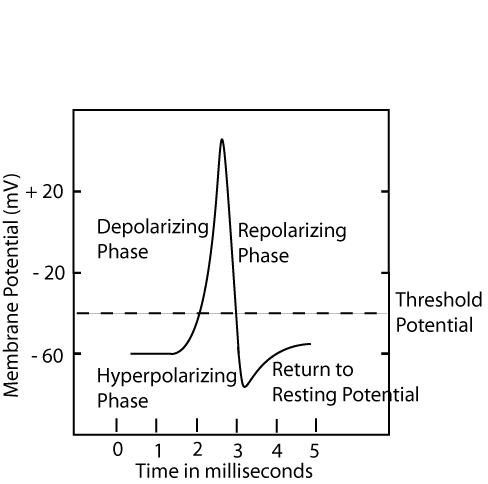
Brief, rapid, large (100mV) changes in membrane potential during which the potential actually reverses, so that the inside of the excitable cell transiently becomes more positive than the outside.
|
| |
|
Depolarization |
|
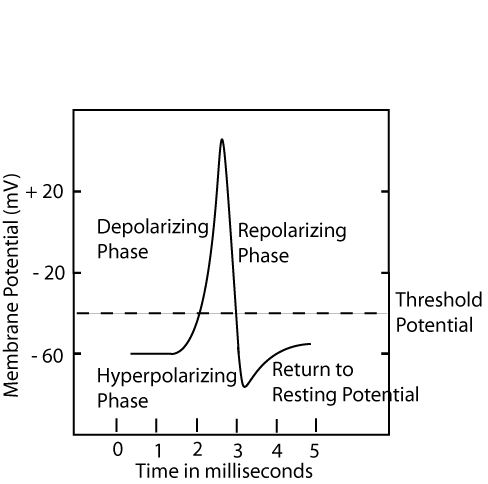
A change in potential that makes the membrane less polarized (less negative) that at resting potential. Depolarization decreases membrane potential, moving it closer to 0mV.
|
| |
|
Repolarization |
|
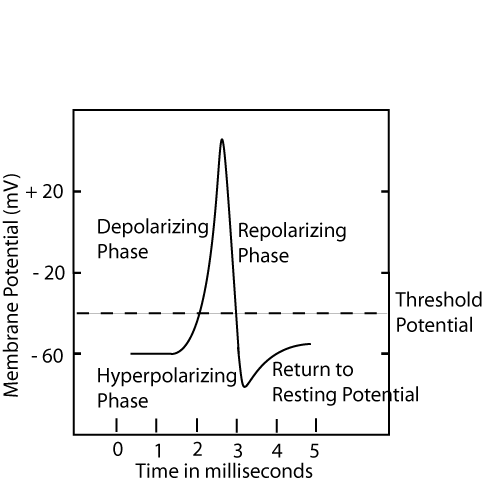
The membrane potential returns to resting potential after having been depolarized.
|
| |
|
Hyperpolarization |
|
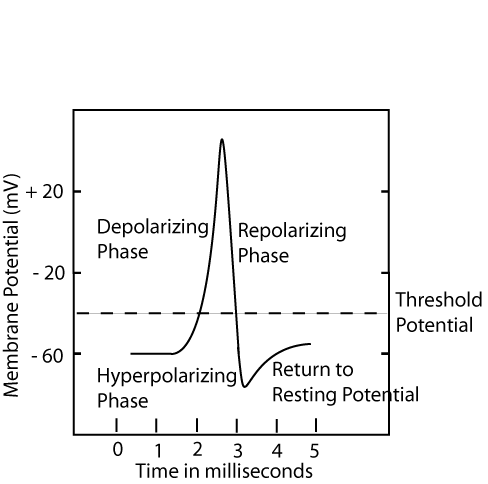
A change in potential that makes the membrane more polarized (more negative) that at resting potential. Hyperpolarization increases membrane potential, moving it even further from 0mV, more charges are separated than at resting potential.
|
| |
|
Threshold Potential |
|
the critical potential that must be reached before an action Totential is initiated in an excitable cell. Typically between -50mV and -55mV. |
| |
|
All or none principle |
|
An excitable membrane either responds to a stimulus with a maximum action potential that spreads nondecrementally throughout the membrane or does not respond with an action potential at all.
|
| |
|
Salatory conduction |
|
The means by which an action potential is propagated throughout a myelinated fiber, with the impulse jumping over the mylinated regions from one node of Ranvier to the next.
|
| |
|
What myelinates in the CNS? |
|
Oligodendrocyte in CNS- (the brain and spinal cord) myelin forming cells. |
| |
|
What myelinates in the PNS? |
|
Schwann cells in PNS- (nerves running between the CNS and the various regions of the body) myelin forming cells. |
| |
|
Nodes of ranvier |
|
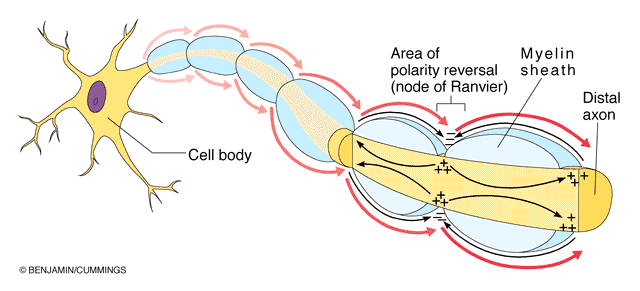
The portions of a myelinated neuronal axon between the segments of insulative myelin; the axonal regions where the axonal membrane is exposed to the ECF and membrane potential exists. |
| |
|
Refractory period |
|
The process by which a new action potential cannot be initiated by normal events in a region that has just undergone an action potential. |
| |
|
Synapse |
|
The specialized junctions between two neurons where an action potential in the presynaptic neuron influences the membrane potential of the postsynaptic neuron by means of the release of a chemical messenger that diffuses across the small cleft that separates the two neurons.
|
| |
|
EPSP's |
|
A small depolarization of the postsynaptic membrane in response to neurotransmitter binding, bringing the membrane closer to the threshold. |
| |
|
IPSP's |
|
A small hyperpolarization of the postsynaptic membrane in response to neurotransmitter binding, therby moving the membrane farther from the threshold. |
| |
|
GPSP's |
|
A composite of all EPSP’s and IPSP’s occurring at approximately the same time.
|
| |
|
Synaptic delay |
|
A conversion of the electrical signal in the presynaptic neuron to an electrical signal in the postsynaptic neuron by chemical means takes time. It is usually between 0.5 to 1 msec.
|
| |
|
Removing neurotransmitters |
|
Neurotransmitters must be inactivated or removed after it has produced the appropriate response in the postsynaptic neuron, however, so that the postsynaptic “slate” is wiped clean, “leaving it ready to receive additional messages from the same or other postsynaptic inputs.
|
| |
|
Cylic AMP |
|
An intracellular second messenger derived from ATP |
| |
|
Permisivness |
|
Situation in which one hormone must be present in adequate amounts for the full exertion of another hormones effect |
| |
|
Voltage gated channels |
|
Channels that open or close in response to changes in resting membrane potential. |
| |
|
What is the axon hilllok and what is it's importance? |
|
The region of the neuron where the axon begins stemming off from the cell body, the soma. It is the trigger zoe of the cell where an action potential is typically initiated. |
| |
|
Target cells |
|
The cells that a particular extracellular chemical messenger, such a hormone or a neurotransmitter, influences. |
| |
|
Polarization |
|
An electrical charge on a cell embrane sruface due to an unequal distribution of positive and negative ions on either side of the membrane. |
| |
|
Hormone |
|
A long distance chemical mediator that is secreted by an endocrine gland into the blood, whch transports it to targe cells. |
| |
|
Presynaptic neuron |
|
The neuron that conducts it's actin potentials towards a synapse |
| |
|
Conduction by local current flow |
|
The means by which an action potential is propagated throughout a NONmyelinated nerve fiber; local current flow between an active and adjacent inactive area brings the inactive area to threshold, triggering an action poential in a previously inactive area; contiguous conduction. |
| |
|
Amines |
|
Hormones derived rom the amino acid tyrosine; included thyroid hormone |
| |
|
Threshold potential |
|
The critical potential that must be reached before an action potential is initiated in an excitable cell. |
| |
|
Steroids |
|
Hormones derived from cholesterol |
| |
|
Paracrine |
|
A local chemical messenger whos effect is exerted only on neighbouring cells in the immediate vicinity of it's site of secretion. A good example is histamine. |
| |
|
Why is the refractory period important? |
|
It prevents the backflow of the action potential which ensures a UNIdirectional flow of the action potential. It is characterized by a period of unresponsiveness to furthur stimulation. |
| |
|
Cytoskeleton |
|
The cytoskeleton is found throughout the cell. Not a rigid structure, constantly rearranging itself, therefore rearranging things in the cell. |
| |
|
Microtubules |
|
The largest component of the cytoskeleton. They are long cylindrical, hollow, don’t have branches, composed of the protein tubulin. Maintain the asymmetry of a cell. Responsible for the cilia (found lining the conducting zones of our respiratory system). |
| |
|
Microfilaments |
|
much smaller then microtubules, cylindrical, composed of the proteins actin and myosin. Involved in contraction of cells. |
| |
|
Intermediate filaments |
|
Help maintain the nuclear position. |
| |
|
Micotrabecular lattice filaments |
|
Found throughout the cell. Very fine meshwork of filaments. It is holding the other components (above) in position, and holding the organelles. Connected to the inner membrane. |
| |
|
Temporal |
|
The summing of several postsynaptic potentials occurring very close together in time because of successive firing of a single presynaptic neuron.
|
| |
|
Spatial |
|
The summing of several postsynaptic potentials arising from the simultaneous activation of several excitatory (or several inhibitory) synapses. |
| |
|
Convergence |
|
The converging of many presynaptic terminals from thousands of other neurons on a single neuronal cell body and its dendrites so that activity in the single neuron is influenced by the activity in many other neurons. |
| |
|
Divergence |
|
The diverging, or branching, of a neuron’s axon terminals, so that activity in this single neuron influences the many other cells with which its terminals synapse. |
| |
|
Glycolysis |
|
Takes place in the cytoplasm. Oxygen is not required, end up with 2 ATPs for glucose
Glucose (6C) -------------- 2 Pyruvic Acids (3C’s)
ADP + Inorganic phosphate-----ATP, binds together |
| |
|
Krebs cycle |
|
Oxygen is necessary. Takes place in the matrix, end up with 2 ATPs per glucose
NAD and FAD pick up hydrogens, some come off during the Krebs cycle
NAD + H --- NADH
FAD + H---FADH2
|
| |
|
Electron transport chain |
|
Oxygen is required, takes place in the cristae, NADH drops off the hydrogens. energy is generated to create ATP. 30+ |
| |
|
Photosynthesis |
|
6CO2 + 6H2O---Sunlight------------- C6H12O6 + 6O2
Photosynthesis, end up with glucose, O2 and energy
C6H12O6 + 6O2-------- 6CO2 + H2O + energy atp and heat |
| |
|
Cytoskeleton |
|
Found throughout the cell. It is constantly rearranging itself |
| |
|
Microtubules |
|
Large componens, long holow, cylinderical, not branched, composed of tubulin (A protein). Important in mandatory asymmetry. |
| |
|
Microtubular Highway |
|
Reverse traffic also, viruses take advantage of it because they will enter the CNS. Examples are rabies, herpes, and polio. |
| |
|
What have a microtubular tail? |
|
Sperm |
| |
|
Microfilaments |
|
Are small and cylindrical. Examples could be actin and myosin |
| |
|
Intermediate Filaments |
|
They help maintain the nuclear position |
| |
|
Microtrabecular lattice |
|
Meshwork of filaments holding other parts of the cytoskeleton and organelles of the cell together. |
| |
|
At resting membrane potential the ICF is more ----- compared to the ECF |
|
negative |
| |
|
mV |
|
Milli volts |
| |
|
It takes ------ to keep charges apart |
|
Energy |
| |
|
Graded potentials: |
|
Short distance, decrimental, strength of the potential is equivalent to the strength of the triggering events. |
| |
|
Action Potentials: |
|
Long distance, non decrimental, All or none |
| |
|
Afferent neurons |
|
From the CNS to the PNS |
| |
|
What are the 3 conformations of a sodium channel? |
|
1. closed but capable of opening2. opened3. closed but capable of opening |
| |
|
Regeneration of nerves cannot occur in the....? |
|
Does not ccur in the CNS |
| |
|
What are triggering events? |
|
1. A change in electrical feild2. Chemical messenger binding on a nerve or muscle membrane3. A stimulus such as sound |
| |
|
Leak channels |
|
Open all the time and allow for unregulated ion access across the membrane |
| |
|
How do water soluble ions pass through the lipid bilayer? |
|
Via channels |
| |
|
Depolarization is an increase OR decrease in membrane potential? |
|
Decrease |
| |
|
Hyperpolarization is an increase OR decrease in membrane potential? |
|
Increase |
| |
|
Gated Channels |
|
Have gates that can open or close. Opening and closing the gates is a direct result of the change in the channels protein shape. It has 4 types. Voltage, chemically, mechanically, and thermal gated channels. |
| |
|
Voltage gated channels |
|
Open and close in response to a change in membrane potential |
| |
|
Chemically gated channels |
|
A change in shape in response to a chemical messenger binding |
| |
|
Mechanically gated channels |
|
Respond to streching or other deformations |
| |
|
Thermally regulated gated channels |
|
Respond to changes in temperature |
| |
|
There are 2 basics forms of electrical impulses...What are they? |
|
Action potentials and graded potentials |
| |
|
The active area of the membrane during a graded potential is a temporarily what region? |
|
An active area of the membrane during a graded potential is a temporarily DEPOLARIZED region |
| |
|
How do graded potntials eventually lose their charge resulting in lose of energy and thus making them ideal short distance signals? |
|
They lose their charge via OPEN channels. It is simililar to that of an uncovered wire. |
| |
|
True or False....Graded potentials can initiate an action potential? |
|
True |
| |
|
Where do graded potentials occur? |
|
The cell body and dendrites |
| |
|
True or false...In a graded potential the current moves in BOTH directions whereas an action potential moves in ONE direction |
|
True |
| |
|
True or False....A graded potential can not excite or inhibite a neuron? |
|
FALSE. A graded potential CAN excite or inhibite a nuron |
| |
|
True or false...During an action potential the membrane potential reverses? |
|
True |
| |
|
How does an action potential begin? |
|
The membrane must depolarize to -50 mV until it reaches threshold potential. Once it reaches it, rapid and dramatic depolarization occurs when the membrane potentials spike to +30mV. This causes a reversal of the positive/negative. Just as soon as it has depolarized it will hyperpolarize and return to resting potential. |
| |
|
What is NA+ equilibrium potential? |
|
+60 mV |
| |
|
What is the peak in mV of an action potential? |
|
+30 mV |
| |
|
What is threshold potential? |
|
-50 mV |
| |
|
True or False...A graded potential uses the "all of none" principle? |
|
FALSE. Only action potentials use the all of none principle. |
| |
|
What makes the greatest contribution to the establishment of the resting membrane potential? |
|
Potassium |
| |
|
What connects the inactivation ball to the sodium channel? |
|
Amino acids |
| |
|
Why is potassium 50-75 times MORE permiable than NA+? |
|
Because there are many more Potassium LEAK channels |
| |
|
During depolarization, what makes sodium continue to enter the cell? |
|
A positive feedback system |
| |
|
What causes the falling phase of an action potential? |
|
Potassium |
| |
|
Where do action potentials begin? |
|
They begin at the axon hillock or the axon terminal |
| |
|
Where is the 'inpute zone' of a neuron? |
|
Dendrites and the cell body |
| |
|
What maintains the concentration gradient of a cell? |
|
The sodium potassium pump |
| |
|
What is the "trigger zone" of a cell? |
|
The axon hillock |
| |
|
What are the two ways an action potential can continue as? |
|
It can continue continuously or it can continue via salatory conduction |
| |
|
What ensures one way propagation of a nerve impulse? |
|
The refractory period |
| |
|
Absolute refractory period |
|
Nothing can trigger another potential until resting membrane potential has been established. |
| |
|
Relative refractory period |
|
An action potential can be generatedonly when the triggering event is stronger than normal |
| |
|
Continous conduction occurs on myelinated or unmyelinated fibers? |
|
UNmyelinated fibers |
| |
|
Schwann cells form myelin in the....CNS, PNS, or both? |
|
PNS |
| |
|
Oligodendrocytes form myelin in.... the CNS, PNS, or both? |
|
CNS |
| |
|
Unmyelinated fibers have an unusually high proportion of what? |
|
Voltage Na+ gates |
| |
|
What is a synapse? |
|
The space inbetween a presynaptic and post synaptic |
| |
|
What does the synaptic knob hold? |
|
Vessicles that hold neurotransmitters that have been packaged by the presynpatic neuron |
| |
|
Where is calcium found? The ECF or the ICF? |
|
It is abundant in the ECF |
| |
|
What role does calcium play in an action potential? |
|
It enters the synaptic knob and causes the release of neurotransmitters in the synapse. |
| |
|
Anions are difussable or NON diffusable? |
|
NON diffusable |
| |
|
What does the Sodium potassium pump, do? |
|
It pumps out 3 sodiums for every 2 potassiums |
| |
|
Propagation |
|
The electrical current |
| |
|
Calcium causes the exocytosis or the endocytosis of cells? |
|
Exocytosis |
| |
|
It usually takes about 50 exitatory post synapatic potentials to get to....? |
|
Threshold |
| |
|
Can a neuron be both post synaptic neuron and pre synaptic neuron? |
|
Yes it can |
| |
|
PNS |
|
Anything that is not part of sensual nervous system. It is outside the brain and the spinal cord. It has to have inputs to the CNS. |
| |
|
The Afferent nervous system |
|
Provides the input to the CNS. It is going to include sensory information. Has visceral and sensory
|
| |
|
Somatic |
|
Affects the skeletal muscles, they are the effectors |
| |
|
Autonomic |
|
Has 2 branches-- the sympathetic division (fight or flight) and the parasympathetic (rest and digest) They both affect the cardiac, smooth muscle and the glands, it is involuntary. |
| |
|
Parasympathetic |
|
Rest and digest |
| |
|
Sympathetic |
|
Fight or flight |
| |
|
Sweat glands are only innervated by the ...? |
|
Sympathetic division |
| |
|
Adrenal glands are only innervated by the....? |
|
Sympathetic division |
| |
|
Blood vessels are only innervated by....? |
|
Sympathetic |
| |
|
Salivary glands are innervated by....? |
|
Both the sympathetic and parasympathetic |
| |
|
Parasympathetic innervation of the saliva glands will result in....? |
|
A lot of aqeous saliva |
| |
|
Sympathetic innvervation of the saliva glands will result in ...? |
|
Small mucous secretions |
| |
|
The parasympathtic system will affect the heart how? |
|
It will slow it down |
| |
|
How does sympathetic activity affect digestion? |
|
It slows it down |
| |
|
Afferent division of the CNS |
|
Carries information to the CNS. |
| |
|
Efferent division |
|
Where instructions from the CNS are carried out to the effector organs (The muscle or organ that is required to carry out that function) |
| |
|
Somatic nervous system |
|
Consists of fibers from the motor neurons that supply SKELETAL muscles |
| |
|
Autonomic nervous system |
|
Innervates smooth muscle, cardiac muscle, and glands. |
| |
|
What 2 branches stem off of the autonomic branch? |
|
The sympathetic and the parasympathetic |
| |
|
Afferent neurons |
|
Has a sensory receptor that begins an action potential in response to a particular stimulus. Doesn't have dendrites. Usually found in the PNS. Action potentials go down the periferal axon. |
| |
|
Efferent neurons |
|
Cell bodies are found in the CNS but they lie primarily in the PNS. |
| |
|
What are the 4 types of extra cellular messengers? |
|
paracrines, neurotransmitters, hormones, and neurotransmitters |
| |
|
Paracrines: |
|
Local messngers whos affect is only exerted on neighboring cells near that cells site of secretion. Only short distance. Inactivated by enzymes. Histamine is a great example of a paracrine. |
| |
|
Neurotransmitters |
|
Respond to target cell. Short distance. React to action potentials |
| |
|
Hormones: |
|
Long range chemical messengers. Secretes by endocrine glnds. Blood carries the hormone. |
| |
|
Neurohormones |
|
Hormones released by neurosecretory neurons. Distributed into the blood to target cells. |
| |
|
Where are steroid hormones derived from? |
|
Cholesterol |
| |
|
Perception of receptors |
|
We cannot percieve all stimulus's. For example, we don't hear a dog whistle because we lack receptors to pick up that high of a tone. |
| |
|
Photoreceptors |
|
Respond to light |
| |
|
Baroreceptors |
|
Respond to pressure |
| |
|
Osmoreceptors |
|
Monitor the concentration of solute particles |
| |
|
Mechanoreceptors |
|
Respond to physical deformations such as streching etc |
| |
|
We have about 2 receptors...What are they? |
|
Tonic and phasic |
| |
|
Tonic |
|
Produce a constant rate of firing as long as the stimulus is applied and maintained.
|
| |
|
Phasic |
|
They adapt. when a stimulus first begins they respond with a burst of firing and they quickly reduce the levels of firing to a lower level. However when the stimulus stops they will respond with another burst of firing. First burst is called the called the OFF response.
|
| |
|
Nocireceptors |
|
Respond to pain. Do not adapt. There are 3 types, Thermal, mechno, and polymodal pain receptors. |
| |
|
Thermal pain receptors |
|
Respond to extreme temperature changes |
| |
|
Mechanopain receptors |
|
Cutting, thrasshing, streching |
| |
|
Polymodal pain receptors |
|
Respond to all sorts of painful stimuli including chemicals released by damaged cells. When cells are damaged they are going to ultimately release prostoglandins, which amplify the pain and making pain receptors more responsive to the pain.
|
| |
|
Prostoglandins |
|
Amplify the pain and making pain receptors more responsive to the pain. |
| |
|
Skeletal muscles |
|
Skeletal. voluntary. somatic affects it via the motor neurons. refered to as mucle fibers. multi nucleated. striated. |
| |
|
What are the levels of a muscle from largest to smallest? |
|
Muscle--muslce fiber--myofibrils--sarcomerre |
| |
|
True or false: a myofibril is a muscle cell? |
|
False, it is only part |
| |
|
What is the functional unit of a muscle? |
|
A sarcomere |
| |
|
What are thick filaments made up of? |
|
Myosin |
| |
|
Thin filaments |
|
Made up of actin (spherical) that will bind together and twist into an actin helix. It has a binding site for myosin cross bridges that are covered by Tropomyosin so that no contraction can occur. |
| |
|
Tropomyosin covers the binding sites of what? |
|
Covers the binding sites of actin |
| |
|
What does Troponin do? |
|
Troponin will stabalize the tropomyosin to cover the binding sites.
|
| |
|
What are the protrusions on thick filaments? What is their significance? |
|
The protrusions on thick filaments are called cross bridges. Each cross bridge has 2 binding sites. 1 for actin and 1 for myosin ATPase. |
| |
|
What happens during a muscle contraction? |
|
As soon as the binding happens between a myson cross bridge and an actin molecule you will get a power stroke. The cross birdges will bend in causing the thin filaments to slide into the center of the sarcomere. This is contraction. |
| |
|
During muscle contraction do either the thick or the thin filaments actually get smaller? |
|
No, they only slide due to the sliding filament mechanism. |
| |
|
TRUE OR FALSE....Calcium is stored in the Sarcoplasmic retticulum? |
|
True |
| |
|
Where is the sarcoplasmic reticulum found? |
|
In skeletal muscle |
| |
|
What does calcium do during a muscle contraction? |
|
Calcium binds to the troponin which will expose the binding sites to break apart from the tropomyosin. As soon as the binding sites are exposed you will see a binding between the myosin cross bridge and the actin. Once this binding occurs you will get a power stroke. |
| |
|
What does an action potential travel down in a muscle? |
|
The action potential travel the membrane and the t tubules. there are segments that lie on either side of the transverse tubules and those parts of the SR have a name called, lateral sacs. |
| |
|
What does a power stroke require? How do we get this? |
|
A power stroke requires energy. A cross bridge has a binding site for ATP and actin. As soon as the ATP binds it’s site to the crossbridge it is going to be split into ADP + phosphate. Once you break those bonds it will release energy. It is going to be stored in the cross bridge, making it energized. If binding occurs it can have that power stroke. |
| |
|
In order for detachment to occur between the myosin cross bridges and the actin....What must occur? |
|
In order for detachment to occur between the myosin cross bridges and the actin a fresh ATP has to bind to the cross bridge. |
| |
|
Why do we get rigor mortis when we die? |
|
When we die we will run out of ATP. Rigor mortis sets in because there isn’t enough atp to bind to the cross bridges, so there is no attachment. Therefore the body is rigid. After a while the proteins will fall apart.
|
| |
|
Motor Unit |
|
It is one motor neuron and all the muscle fibers that it innervates. They help make sure that not all parts of the muscle have to contract at the same time. |
| |
|
What is motor unit recruitment? |
|
It refers to the activation of more and more motor units to develop more strength as needed. Once they are all acivated you have reached maximum strength of that muscle.
|
| |
|
Asynchronous motor unit recruitment |
|
Involved with helping the muscles involved with posture |
| |
|
Tetanie |
|
When you get a smooth sustansed contraction because you are firing the AP so fast that you don’t give it a chance to relax.
|
| |
|
What are the 3 types of fatigue? |
|
Neuromuscular, muscular, and psychological fatigue |
| |
|
Muscular Fatigue |
|
Due to the depleetion of energy reserves. and the build up of lactic acid. It is the muscle that can’t respond to stimulation with the same degree of contraction
|
| |
|
Neuromuscular fatigue |
|
The motor neurons that can’t synthesize the ACH fast enough to sustain the contraction.
|
| |
|
Psychological fatigue |
|
It is the CNS that does not activate hte motor neurons which supply the muscle.
|
| |
|
How are muscle fibers classified? |
|
Classified two ways: the speed of contraction (fast and slow fibers) and the primary way that the fiber uses to synthesis ATP. |
| |
|
Fast Oxidative fibers |
|
Gets ATP from electron transport chain (occurs in the mitochondria). These fibershave an abundace of mitochondria. Needs oxygen. Highly vascularized fibers. Have many molecules of moyglobin (help support the oxidative fibers). They are fatigue resistant because of how much ATP is makes. “red meat” fibers |
| |
|
Slow Oxidative Fibers |
|
SLOW. Gets ATP from electron transport chain (occurs in the mitochondria). These fibershave an abundace of mitochondria. Needs oxygen. Highly vascularized fibers. Have many molecules of moyglobin (help support the oxidative fibers). They are fatigue resistant because of how much ATP is makes. “red meat” fibers |
| |
|
Fast Glyocolytic Fibers |
|
Uses glycolysis. Occurs in the cytoplasm. Doesn’t need as many mitochondria then fast or slow oxidative fibers. Less vascularized. Less myoglobin. “white meat” fibers. They fatigue much easier.
|
| |
|
Aging of muscles |
|
We lose up to 30 percent of our muscle fibers. The motor unit size decreases. The diameter of it decreases. The neuroactivity to the muscle decreases because the motor neurons get less efficient at making ACH.
|
| |
|
Muscle Spindles |
|
Our brain has to be aprised of the position of our muscles. So we have structures in our muscles called muscle spindles that relay muscle position. They have intrafussal fibers that have afferent innervation. When they are streched it causes an action potential to go to the CNS.
|
| |
|
Reflexes |
|
Important becasue they allow us to react very quickly. Spinal reflexes you react before the message gets to your brain. It is predictable.
|
| |
|
Creatine Phosphate |
|
One step process to get ATP. You get ATP + creatine
|
| |
|
A bands |
|
thick filaments |
| |
|
What does CA bind to to release the troponin/tropomyosin complex? |
|
CA binds to troponin |
| |
